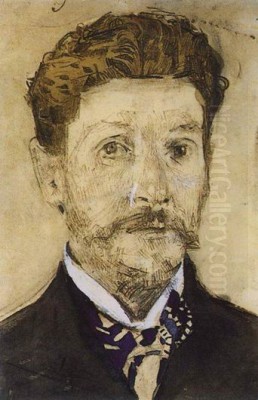
Mikhail Aleksandrovich Vrubel stands as a colossus in the landscape of Russian art. Born on March 17, 1856, in Omsk, Siberia, and passing away on April 14, 1910, in St. Petersburg, Vrubel navigated the complex currents of late 19th and early 20th-century art, leaving an indelible mark through his unique fusion of Symbolism, Art Nouveau, and deeply personal interpretations of myth, religion, and the human psyche. His life was one of intense creativity, profound struggle, and eventual, though often posthumous, recognition as a pivotal figure bridging traditional Russian art and the burgeoning avant-garde.
Early Life and Artistic Awakening
Vrubel's early years were marked by the peripatetic life of a military family. His father, Aleksandr Mikhailovich Vrubel, was an officer whose career necessitated frequent relocations across the vast Russian Empire, including stints in cities like St. Petersburg and Moscow. This constant movement, coupled with the early death of his mother, Anna Grigorievna (née Basargina), contributed to a complex and perhaps unsettled childhood environment. His father later remarried, further shaping the young Mikhail's formative experiences. These early encounters with displacement and loss arguably sowed the seeds for the themes of melancholy, searching, and spiritual intensity that would later permeate his art.
Despite this somewhat turbulent upbringing, Vrubel displayed an early aptitude for drawing and the visual arts. However, following a more conventional path initially, he enrolled in the Faculty of Law at St. Petersburg University. Even while pursuing legal studies, his passion for art remained undimmed, and he continued to draw and engage with the artistic currents of the capital. The pull of art proved irresistible.
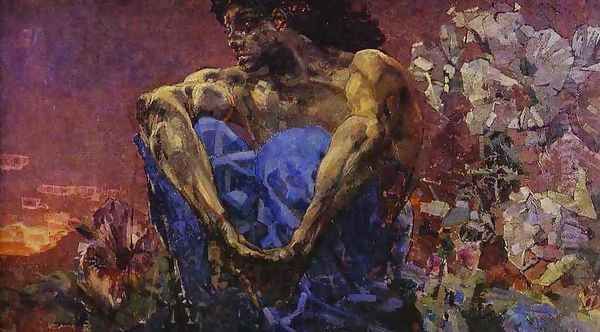
Eventually, Vrubel abandoned law and, in 1880, entered the prestigious Imperial Academy of Arts in St. Petersburg. This decision marked the true beginning of his professional artistic journey. At the Academy, he came under the tutelage of the highly respected Pavel Chistyakov, a master draftsman and influential teacher whose pedagogical methods emphasized rigorous anatomical study, precise drawing, and a deep understanding of form and structure. Chistyakov's demanding training instilled in Vrubel a technical foundation that would underpin even his most fantastical creations. Among his fellow students influenced by Chistyakov's methods were future luminaries of Russian art such as Ilya Repin, Vasily Surikov, Vasily Polenov, and Valentin Serov, creating a fertile ground for artistic development.
The Transformative Kyiv Period
A crucial chapter in Vrubel's development unfolded in Kyiv (Kiev) between 1884 and 1889. He was invited there by the prominent art historian and archaeologist Adrian Prakhov to participate in the restoration of the 12th-century St. Cyril's Church. This immersion in the world of ancient Rus' and Byzantine art proved profoundly influential. Vrubel meticulously studied the surviving medieval frescoes, mosaics, and icons, absorbing their spiritual intensity, monumental forms, and distinctive color palettes.
His work at St. Cyril's was not merely restorative; he created original murals and icons that synthesized these ancient traditions with his own burgeoning style. Works such as Descent of the Holy Spirit and studies like Angel with Censer and Candle demonstrate his ability to capture the solemn grandeur of Byzantine art while infusing it with a modern psychological depth. This period solidified his fascination with monumental forms, rich, jewel-like colors, and themes of spirituality and transcendence, elements that would become hallmarks of his mature style. His time in Kyiv also exposed him to the influence of Venetian Renaissance masters, further enriching his artistic vocabulary.
Forging a Unique Vision: Symbolism and Innovation
Returning from Kyiv, Vrubel entered his most prolific and stylistically defining period. He became a central figure in the Russian Symbolist movement and closely associated with the Art Nouveau style (known as Stil Modern in Russia). His art rejected the prevailing Realism of the Peredvizhniki (Wanderers) movement, favoring instead introspection, mysticism, and the exploration of the subconscious. He sought to depict not the external world, but the inner reality of emotions, dreams, and spiritual states.
Vrubel's style is characterized by its distinctive "crystalline" technique. He often broke down forms into fragmented, intersecting planes and facets, resembling cut gemstones or stained glass. This method created a shimmering, mosaic-like surface texture that dematerialized figures and landscapes, imbuing them with an otherworldly quality. This innovative approach to form has led many art historians to consider him a precursor to later movements like Cubism.

His use of color was equally bold and expressive. He employed rich, often contrasting hues – deep blues, purples, golds, and iridescent tones – to create dramatic and emotionally charged atmospheres. His compositions were frequently complex, dynamic, and unconventional, drawing the viewer into enigmatic and psychologically intense narratives. Themes drawn from Russian folklore, Byzantine spirituality, classical mythology, and literature (particularly the works of Mikhail Lermontov) became central to his oeuvre.
Moscow, Mamontov, and Multifaceted Creativity
During the 1890s, Vrubel spent significant time in Moscow, where he became closely associated with the Abramtsevo Colony, an artistic community fostered by the wealthy industrialist and influential arts patron Savva Mamontov. Mamontov was a crucial supporter, commissioning works from Vrubel and providing a platform for his often controversial art. The Abramtsevo circle, which included artists like Viktor Vasnetsov, Konstantin Korovin, and Valentin Serov, aimed to revive traditional Russian folk art and crafts while embracing modern European artistic trends.
Vrubel thrived in this environment, expanding his creative output beyond painting. He became deeply involved in decorative arts, designing ceramics, majolica panels, and sculptures that showcased his distinctive style. His work in applied arts blurred the lines between "high" art and craft, reflecting the holistic ideals of the Art Nouveau movement.
His talents also extended to stage design. He created visionary sets and costumes for Mamontov's private opera company, most notably for Nikolai Rimsky-Korsakov's opera Sadko and later The Tale of Tsar Saltan. It was through his work in opera that he met the renowned soprano Nadezhda Zabela, who became his wife in 1896. She served as his muse, and he painted numerous striking portraits of her, often in her stage costumes, capturing both her physical likeness and the fantastical characters she embodied. Notable collectors like Ilya Ostroukhov and V.V. von Meck also recognized his talent and acquired his works during this period.
Masterpieces and Defining Themes
Vrubel's legacy is defined by a series of powerful and unforgettable works that encapsulate his artistic obsessions. Among the most famous is his "Demon" series, inspired by Mikhail Lermontov's romantic poem. These paintings explore themes of isolation, pride, spiritual torment, and the yearning for beauty and harmony.
_Demon Seated_ (1890): Perhaps his most iconic work, it depicts a muscular, melancholic figure brooding amidst a landscape of fractured, crystalline mountains under a sunset sky. The Demon is portrayed not as purely evil, but as a powerful, tragic figure embodying loneliness and spiritual searching. The use of deep blues and purples enhances the mood of profound introspection.
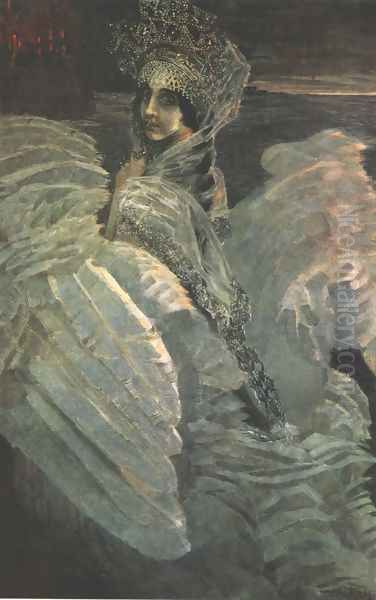
_The Flying Demon_ (1899): A dynamic and unsettling composition showing the Demon in flight over the Caucasian mountains, conveying a sense of restless power and inner turmoil.
_Demon Downcast_ (1902): Created during a period of intense mental strain for the artist, this work shows the Demon broken and defeated, his body fragmented amidst a chaotic, jewel-like background. It is often seen as a reflection of Vrubel's own psychological struggles.
Beyond the Demon, other masterpieces highlight the breadth of his imagination:
_The Swan Princess_ (1900): Inspired by Rimsky-Korsakov's opera The Tale of Tsar Saltan (for which Vrubel designed sets and his wife sang the lead role), this painting is a quintessential example of Russian Art Nouveau. It captures the magical transformation of the princess with shimmering, iridescent colors and a dreamlike atmosphere.
_Pan_ (1899): Drawing on Russian folklore rather than Greek mythology, this work depicts a mischievous, earthy nature spirit emerging from a twilight landscape, blending pagan energy with Symbolist mystery.
_Fortune Teller_ (1895): A vibrant work showcasing Vrubel's decorative flair and interest in enigmatic female figures.
_Pearl_ (1904): Painted during a period of hospitalization, this intricate work depicts fantastical sea creatures swirling within an oyster shell, demonstrating his enduring creative power even amidst personal adversity. Its near-abstract quality points towards future artistic developments.
_Six-Winged Seraph (Azrael)_ (1904): Another late masterpiece, this powerful image, inspired by Pushkin's poem "The Prophet," features a formidable angel rendered in Vrubel's characteristic faceted style, radiating intense spiritual energy.
_Portrait of the Artist's Son_ (1902): A poignant depiction of his young son, Savva, capturing a sense of vulnerability that contrasts with the monumentality of his mythological works.
These works, alongside others like The Parting of the Sea King and Princess Volkhova (1898) and religious explorations like Christ on Calvary (1888), showcase his unique blend of technical mastery, decorative sensibility, and profound psychological depth.
Controversy, Recognition, and Personal Tragedy
Vrubel's art was often too radical for contemporary tastes. His fragmented forms, intense colors, and disturbing themes frequently met with incomprehension and criticism from the conservative art establishment and the public. His innovative style clashed sharply with the dominant Realist aesthetic, and he was sometimes accused of incompetence or deliberate eccentricity. The rejection of his large panels commissioned for the Nizhny Novgorod exhibition in 1896, despite Mamontov's efforts to display them independently, was a significant public setback.
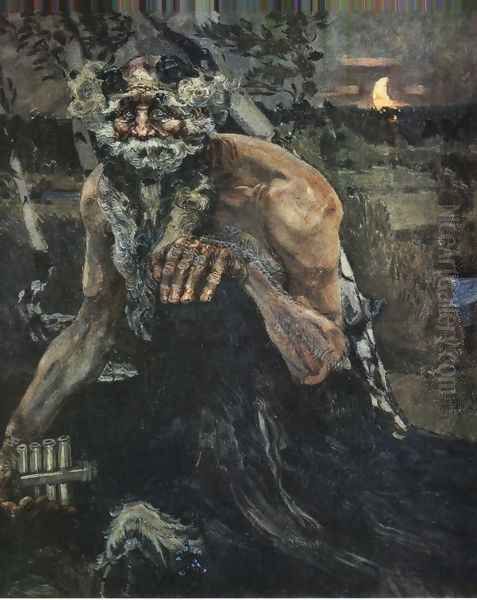
Despite the controversy, Vrubel gradually gained recognition among progressive art circles and influential patrons. He was a key member of the Mir Iskusstva (World of Art) movement, which championed Symbolism and Art Nouveau in Russia. His interactions within this circle, which included artists like Léon Bakst and Alexandre Benois, were crucial, even if detailed records of specific collaborations are scarce. He certainly interacted with contemporaries like Mikhail Nesterov and Konstantin Korovin within these artistic milieus. In 1905, his contribution was formally acknowledged when he was awarded the title of Academician of Painting by the Imperial Academy of Arts – a significant, if belated, honour.
However, Vrubel's later years were overshadowed by profound personal tragedy and declining mental health. The birth of his son, Savva, in 1901 brought joy but also immense sorrow, as the child was born with a cleft lip. This deeply affected the sensitive artist. Tragically, Savva died in 1903. This loss, combined with the intense creative pressure Vrubel placed upon himself (particularly while working on Demon Downcast), contributed to a severe mental breakdown in 1902.
Vrubel began experiencing periods of intense mania followed by debilitating depression. He was hospitalized multiple times in various clinics. His condition was likely exacerbated by tertiary syphilis, a common affliction at the time with devastating neurological consequences. Despite periods of lucidity where he continued to create remarkable works like Pearl and the Six-Winged Seraph, his health steadily deteriorated. He suffered from failing eyesight, eventually going blind. Mikhail Vrubel spent the last few years of his life in a clinic in St. Petersburg, where he died in 1910.
Enduring Legacy and Influence
Mikhail Vrubel's death marked the end of a tumultuous but brilliantly creative life. Though often misunderstood during his time, his artistic legacy proved immense and enduring. He is now universally recognized as a pivotal figure in Russian art, a master of Symbolism and Art Nouveau, and a crucial precursor to the Russian avant-garde.
His unique style, characterized by its emotional intensity, spiritual depth, formal innovation, and decorative richness, broke decisively with 19th-century Realism and opened new pathways for artistic expression. His 'crystalline' technique anticipated the fragmentation of form explored by Cubism, while his expressive use of color and exploration of inner psychological states resonated with later Expressionist movements.
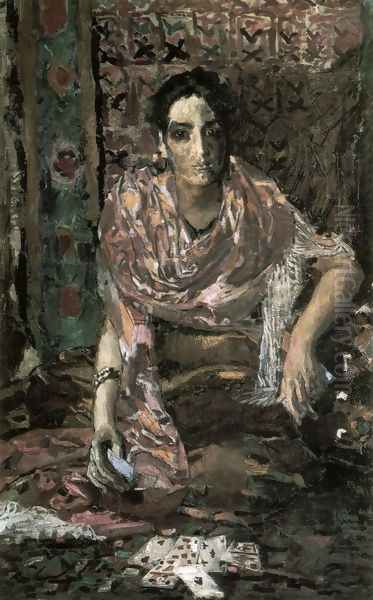
Vrubel exerted a profound influence on the subsequent generation of Russian artists who would revolutionize art in the early 20th century. Figures like Wassily Kandinsky, often credited as a pioneer of abstract art, acknowledged Vrubel's impact, particularly his liberation of color and form from purely representational constraints. Kazimir Malevich, the founder of Suprematism, also looked to Vrubel's spiritual and formal explorations. Other key figures of the Russian avant-garde, including Aleksandr Rodchenko, Lyubov Popova, and Vladimir Tatlin, absorbed aspects of Vrubel's innovative approach to composition and his willingness to experiment across different media.
Conclusion
Mikhail Vrubel remains a fascinating and complex figure – an artist of immense talent whose work plumbed the depths of myth, spirituality, and the human condition. His life journey, marked by both extraordinary creativity and profound suffering, mirrors the dramatic intensity found in his art. By synthesizing ancient traditions with modern sensibilities, and by daring to visualize the unseen worlds of the psyche and spirit, Vrubel forged a unique artistic language that significantly shaped the course of Russian modernism. His paintings, sculptures, and designs continue to captivate viewers with their enigmatic beauty, emotional power, and visionary brilliance, securing his place as one of the most important and original artists in Russian history.